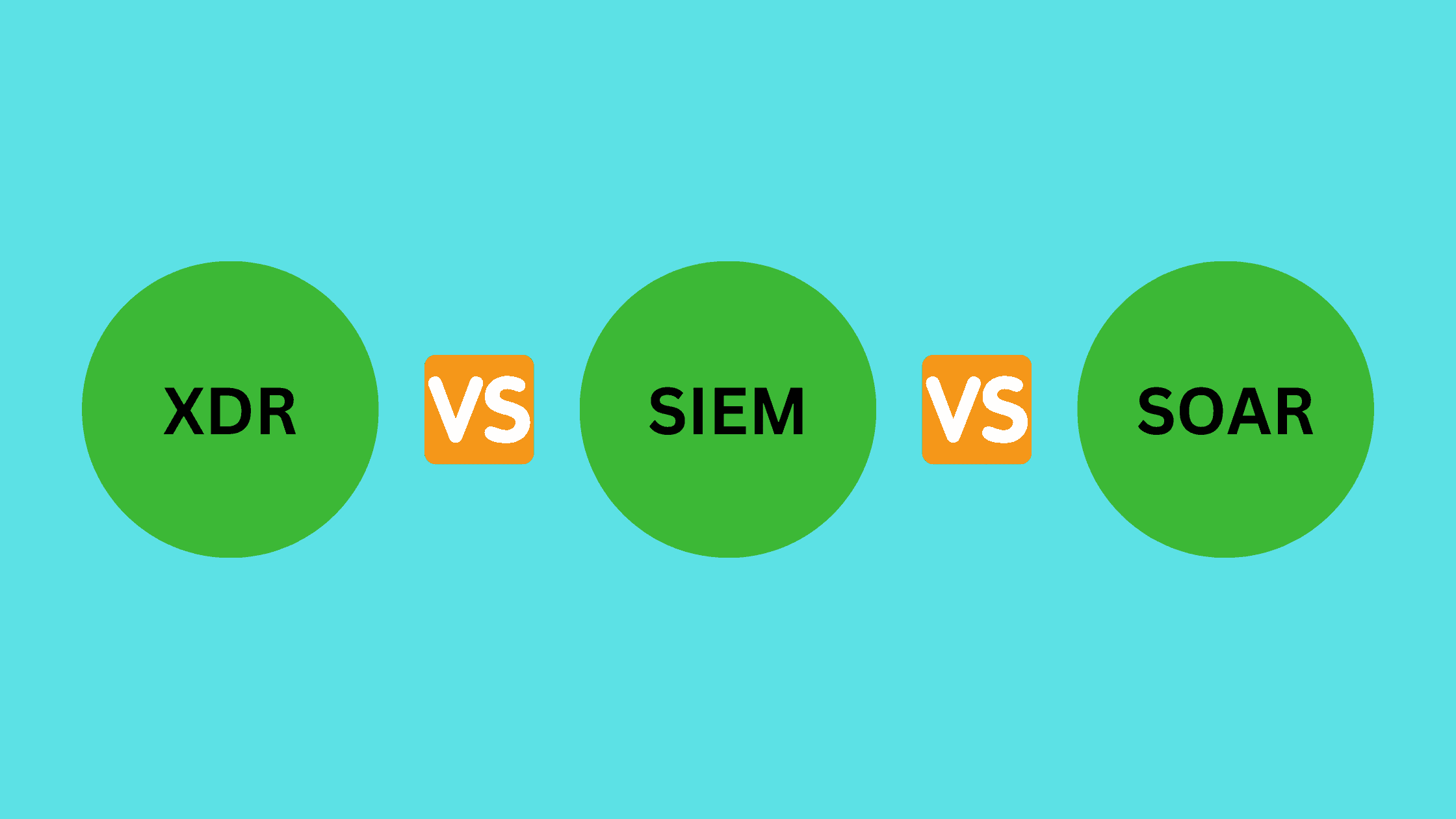Table of Contents
SOAR vs SIEM vs XDR: Understanding Key Differences
Modern cybersecurity defense depends on detecting threats early and responding swiftly. Yet the expanding attack surface with cloud, mobile, IoT and hybrid workloads strains security teams struggling with manual processes and too many disconnected tools. Threat detection rates barely exceed 50% while dwell times average over 200 days. To modernize security operations, three key solutions take center stage – Security Orchestration, Automation and Response (SOAR), Security Information and Event Management (SIEM), and extended Detection and Response (XDR). While their 3-letter acronyms sound familiar, gaps in understanding their distinct capabilities lead to integration challenges. SOAR delivers automation, SIEM provides analytics and XDR consolidates visibility and protection.
This blog clarifies what each uniquely offers, their integration with security processes, optimal use cases and reference deployment architecture. We also showcase why accelerating threat management requires a tight interplay between the automation and seamless sharing of contextual security data across SOAR, SIEM and XDR solutions.
Defining SOAR, SIEM and XDR
Let’s start by clearly defining what each solution refers to:
SOAR – Security Orchestration, Automation and Response tools like Splunk SOAR and IBM SOAR. Used to streamline and automate security operations processes.
SIEM – Security Information and Event Management platforms like Splunk, QRadar and Microsoft Sentinel. Aggregates, analyzes and correlates security data.
XDR – eXtended Detection and Response suites like Trend Micro XDR and Microsoft Defender XDR. Unify visibility and protection across multiple control points.
While their expansions seem complex, it helps remembering that SOAR brings automation, SIEM enables security analytics and XDR provides unified threat detection and response across your digital estate.
Key Differences and Use Cases
While SOAR, SIEM and XDR platforms aim to improve threat management, their capabilities and ideal use cases differ:
SOAR solutions excel at automating security operations processes via seamless orchestration and smart workflows. Core use cases include:
Automating incident response by unifying and governing workflows across security tools to accelerate triage, investigation, and containment.
Enriching threat context by looking up indicators of compromise across threat intel feeds and dynamically adapting response playbooks with the latest IOCs.
Optimizing Tier 1 analyst tasks via rule-based auto-remediation of common threats enabling them to focus on priority investigations.
SIEM platforms aggregate and analyze security data to enhance monitoring, threat detection, and investigations. Typical use cases:
Centralizing visibility of user activity logs, DNS traffic, endpoint security events, etc. to baseline normal behavior.
Applying analytics techniques like correlation rules, anomaly detection, and machine learning algorithms to uncover IOCs and advanced threats.
Empowering threat hunting and forensics by rapidly searching through historical activity using advanced query capabilities.
XDR solutions consolidate visibility, analytics and protection capabilities across heterogeneous environments. Key applications:
Unifying detection and response across network layers, endpoints, identities, apps, cloud workloads etc.
Leveraging threat telemetry and IOCs from endpoints to initiate scans, isolate compromised users/devices and harden network security postures.
Proactively hunting for threats across digital assets by leveraging behavioral analytics and ML to identify anomalies and suspicious activities.
Integrating SOAR, SIEM and XDR
An effective approach for deploying SOAR, SIEM, and XDR is to start by implementing XDR solutions to monitor critical infrastructure and environments. For securing endpoints, deploy an agent-based XDR solution across all devices to collect detailed security telemetry and detect threats. For cloud environments, implement a cloud-native XDR solution that integrates with infrastructure components to monitor virtual machines, storage, networks, and applications.
After initial XDR coverage is established, implement an SIEM solution that can ingest the range of log data and alerts from XDR systems. Choose an SIEM like Microsoft Sentinel that supports easy onboarding of new data sources. Configure the connection of XDR data to automatically stream into the SIEM’s data lake. Then leverage the SIEM’s analytics capabilities to correlate insights across environments, monitor dashboards, and create threat detection content like alerts and incident triggers.
With foundational visibility through XDR and SIEM, SOAR capabilities can maximize incident response efficiency. Evaluate if existing XDR and SIEM solutions have integrated SOAR functionality for responding to incidents. If not, deploy a dedicated SOAR solution capable of connecting security tools through APIs. Key SOAR automation includes translating alerts into incidents, triaging severity, enacting enrichment like IP reputation lookup, creating tickets in service management systems, and facilitating threat-hunting workflows.
As solutions scale, governance is critical for security efficiency. Establish processes for periodically reviewing data sources, detection logic, and response playbooks. Measure the effectiveness of use cases and continue aligning capabilities to impactful security outcomes. Foster collaboration between security and IT teams on priorities and objectives. Lastly, create recurring training to uplift staff skills and optimize the utilization of deployed security tools. By taking an iterative, metrics-based approach, organizations can drive continuous improvement and maximize their return on investment from modern security solutions.
Looking to leverage SOAR, SIEM, and XDR capabilities as part of your cybersecurity strategy? Get in touch with our team for expert guidance tailored to your requirements.
We hope this post helped in understanding the key differences between SOAR vs SIEM vs XDR solutions and how integrating them supercharges threat detection. Thanks for reading this post. Please share this post and help secure the digital world. Visit our website, thesecmaster.com, and our social media page on Facebook, LinkedIn, Twitter, Telegram, Tumblr, Medium, and Instagram and subscribe to receive updates like this.
You may also like these articles:
Arun KL
Arun KL is a cybersecurity professional with 15+ years of experience in IT infrastructure, cloud security, vulnerability management, Penetration Testing, security operations, and incident response. He is adept at designing and implementing robust security solutions to safeguard systems and data. Arun holds multiple industry certifications including CCNA, CCNA Security, RHCE, CEH, and AWS Security.
